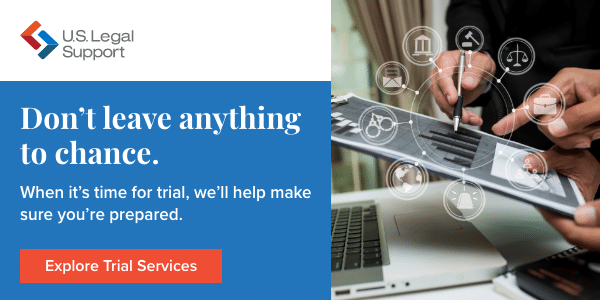Cybersecurity’s Role in Legal Transcription

Legal transcription services play a vital role in legal matters, ensuring that live oral arguments and other audio or video content are fully accessible to all stakeholders in text. When managing transcription files—especially those that may contain sensitive data like protected health information (PHI)—law firms must exercise extreme caution. Compliance with regulations like the Health Insurance Portability and Accountability Act (HIPAA) is essential when transcriptions are tied to healthcare-related cases, as legal professionals are considered business associates under the law.
Cybersecurity is a crucial part of any law firm’s information technology (IT) infrastructure, and that includes internal and external platforms used for legal transcription. From securing PHI to meeting evolving compliance standards, transcription-related security must be airtight.
Below, we’ll explain why cybersecurity is so important in this niche before breaking down specific challenges faced and solutions for them. We’ll also cover what to look for in the ideal legal transcription partner.
Why Cybersecurity Matters in Legal Transcription
At a base level, cybersecurity matters in the legal profession because of the risks associated with handling sensitive legal documents. Strong security ensures that confidentiality is maintained and that only individuals authorized to view a document can do so. These same protections also need to ensure that individuals who have a right to view the data have the ability to access it at will, up to any applicable governmental or other standards.
In digital environments, the risks associated with handling physical documents coexist with an ever-expanding set of threats from hackers and other cybercriminals. Since transcription inherently deals with translation and transporting information between file types and formats, there are additional variables that legal teams need to be aware of.
Common Cybersecurity Threats in Legal Transcription
Legal transcription security is plagued by many of the same threats impacting other online and virtual environments where legal documents are stored, shared, and/or processed.
Some of the biggest threats to legal transcription security include:
- Data breaches – When attackers gain unauthorized access to transcripts, by whatever means, sensitive data is likely compromised by regulatory standards.
- Social engineering – Cybercriminals may target staff or other stakeholders with phishing attacks to elicit information they can use to breach systems and data.
- Malicious software – Especially in cloud-based transcription services, malicious programs or code can steal sensitive information without being detected.
- Insider threats – Whether intentional or not, improper data handling by legal professionals or other staff who contact transcriptions can lead to data leakage.
To combat these risks, legal teams should implement a set of consensus best practices.
Best Practices for Securing Legal Transcription Data
Transcribed data needs to be protected during intake, data processing, communication, and all other related processes. At a base level, this means utilizing secure cloud storage and enforcing strict access policies. Users need to be authenticated when handling sensitive files so they remain secure.
As an added measure, end-to-end encryption secures transcription data by making it unreadable and unusable if it falls into the wrong hands. Cryptographic controls also require regular maintenance to ensure keypairs and related information are safeguarded.
Other best practices for confidentiality include using secure transfer protocols, implementing system-wide training and monitoring, and leveraging non-disclosure agreements (NDAs).1 This way, firms cover all their bases with technical controls, formal programmatic awareness, and contractual obligations that ensure accountability from staff, clients, and other stakeholders.
With the right transcription provider, you can trust that your content remains secure.
The Role of Technology in Legal Transcription Services
Technology facilitates secure and effective legal transcription by building security into the process of transcribing and managing legal documents. Using secure platforms to host, transcribe, and otherwise interact with sensitive documentation keeps all stakeholders safe—from the moment files are uploaded to whenever they’re archived or otherwise offboarded.
In particular, smart technology implementation gives law firms and legal departments tools for detecting, preventing, mitigating, and recovering from threats and incidents. In security parlance, risk generally refers to the relationship between vulnerabilities (weaknesses) and threats that could exploit them—threat actors (cybercriminals) and vectors (means they use).
While completely eliminating all sources of risk is near-impossible, technology enables risk management through monitoring and mitigation. Perimeter defense tools allow firms to detect and identify new threats, such as unknown entities or activities on their networks, and react accordingly. This way, legal teams can set a reasonable risk tolerance and operate within it.
How Automation Streamlines Security and Compliance
Automation in transcription not only speeds up processes but bolsters data protection through reduced human error. Artificial intelligence (AI) can be used to streamline transcription for faster results without compromising security. In addition, it can contribute to better risk detection and mitigation.
Automation and legal AI more broadly impact legal transcription security by way of:
- Data processing – By minimizing human contact with transcription data, automation limits the possibility of human error and the capacity for intentional security lapses.
- System monitoring – Visibility tools can be configured to perform scans of both individual files and entire systems at regular intervals, detecting risks immediately.
- Threat notifications – These same tools can trigger automatic reporting to set mitigation tactics in action and satisfy regulatory breach reporting requirements.
Most importantly, AI tools allow for enhanced security without compromising speed, accuracy, or other qualities law firms prioritize when comparing types of transcription services.
Ensuring Compliance with Cybersecurity Standards
Compliance is one of the most important and challenging elements of cybersecurity. The sensitive information that law firms work with needs to be protected because of the risks data breaches pose to the individuals it concerns. Another major reason that this data needs to be kept secure is that failing to do so may put firms or individual professionals at risk for fines or criminal penalties administered by governmental and other regulatory authorities.
In addition, compliance and non-compliance can have indirect impacts on a firm’s standing within an industry or location—or reputation among current or potential clients therein.
Staying compliant while using digital transcription solutions requires careful planning and potential control implementation to ensure that all requirements are met. The best platforms have some extent of these protections built in, along with dedicated service teams that help legal professionals identify which regulations apply and whether their transcription complies.
Complying with Industry-Specific Cybersecurity Guidelines
Law firms that work predominantly with clients in a given industry are likely aware of the regulatory landscape within it. But even firms with a single client or case involving a protected data class may need to follow strict rules about how transcription documents are handled.
Two such industry-specific standards legal professionals need to be familiar with include:
- HIPAA – The Health Insurance Portability and Accountability Act of 1996 (HIPAA) applies both to covered entities within healthcare and business associates who work alongside them.2 This includes law firms and other legal assistance, especially when services provided involve transcriptions containing protected health information (PHI).
- SOC 2 – The American Institute of Certified Public Accountants (AICPA) governs several System and Organization Controls (SOC) regulations to ensure financial and other service organizations’ security. If legal transcriptions are hosted on a cloud server, there’s a good chance clients will require a SOC 2 Report from your firm.3
Legal transcription security protections should ensure that sensitive information related to these standards (PHI and information on internal controls) is safeguarded. In some cases, more than one such standard may apply—in addition to other, government-mandated ones.
Complying with Location-Based and International Regulations
Cybersecurity regulations imposed by national, local, and other government authorities are often even further-reaching than industry-specific ones. They may apply to all businesses in a specific area, and they can even apply based on the location of clientele rather than a given organization’s own location. Legal transcriptions involving multi-national corporations may need to abide by international laws even if no parties involved in the case ever leave the U.S.
One example is the European Union (EU) General Data Protection Regulation (GDPR), which imposes relatively strict privacy requirements on most businesses that collect EU residents’ data. These typically apply irrespective of where the business in question is located, and the penalties for failing to protect data subjects’ privacy rights can reach well over €20 million.4
Law firms transcribing documents that involve international business need to ensure their platforms and general data processing abide by GDPR and other standards. Data protection in the U.S. differs significantly from other parts of the world, adding a layer of complexity.
Choosing a Secure Legal Transcription Provider
When comparing legal service providers, be sure to inquire about their transcription security posture. To start, confirm that the platform or service takes data security seriously. Seek out explicit commitments to privacy and confidentiality and, if possible, accreditation or compliance with regulations your firm is subject to for a given case.
Beyond these fundamentals, seek out providers who espouse the best practices outlined above. The best transcription platforms, again, have security features built in. They also allow for flexibility, as legal teams may take different approaches to meet or exceed regulatory and other requirements. You need to be able to offer stakeholders the same security assurance in transcription as you do across your overall IT infrastructure.
U.S. Legal Support ensures secure, confident legal transcription without compromising on accuracy or efficiency, We leverage the best available technology, including automation tools, to ensure that all transcribed information and documents remain safe and compliant.
Optimize Your Transcription Security Today
Legal transcription security ensures that individuals’ privacy rights are protected and law firms comply with applicable data security regulations. Best practices to implement include end-to-end encryption and access controls. What’s more, firms should seek out explicit commitments to security—along with efficiency and accuracy—when comparing legal transcription providers.
U.S. Legal Support offers secure legal transcription to law firms in all practice areas and locations. Our platform facilitates compliance with all major regulations, and we provide robust support to make sure your team can transcribe documents securely and swiftly.
To learn more about how we can help, get in touch today!
Sources:
- Forbes. The Role Of Confidentiality And Security In Legal Transcription. https://www.forbes.com/councils/forbesbusinesscouncil/2024/04/09/the-role-of-confidentiality-and-security-in-legal-transcription/
- U.S. Department of Health and Human Services. Covered Entities and Business Associates. https://www.hhs.gov/hipaa/for-professionals/covered-entities/index.html
- Lawyer Monthly. Navigating SOC 2 Compliance as a Law Firm. https://www.lawyer-monthly.com/2020/04/navigating-soc-2-compliance-as-a-law-firm/
- Intersoft Consulting. GDPR Fines / Penalties. https://gdpr-info.eu/issues/fines-penalties/

Editoral Policy
Content published on the U.S. Legal Support blog is reviewed by professionals in the legal and litigation support services field to help ensure accurate information. The information provided in this blog is for informational purposes only and should not be construed as legal advice for attorneys or clients.


